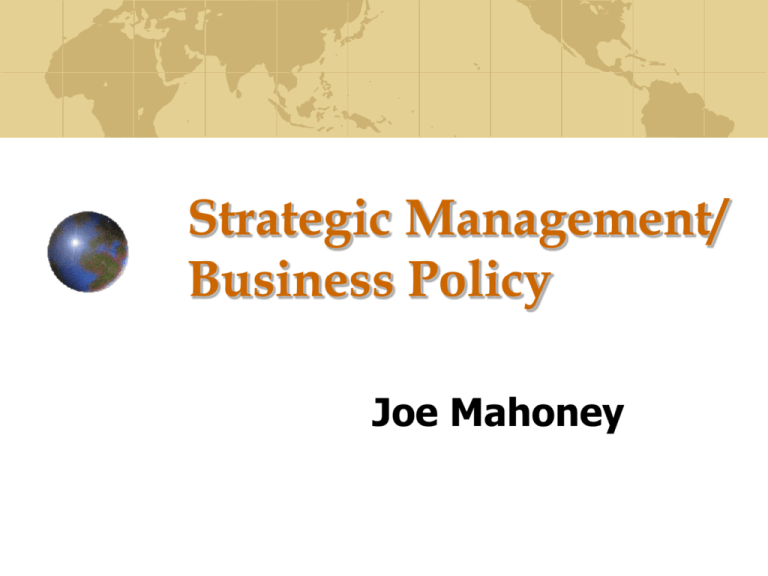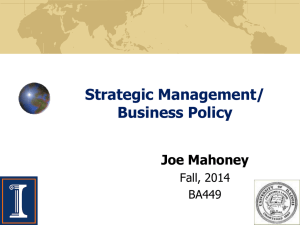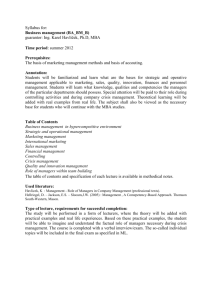
Strategic Management/
Business Policy
Joe Mahoney
Background of Joe Mahoney
Grew up in Philadelphia, PA.
One younger sister (BA University of Pennsylvania; MBA
accounting).
One younger brother (Ph.D. Finance, Wharton).
BA in Economics in 1980 University of Pennsylvania.
MA in business economics 1984 from Wharton School of
Business of University of Pennsylvania.
Ph.D. in business economics in 1989 from Wharton
School of University of Pennsylvania.
2
Background of Joe Mahoney
Tenure-track faculty member in business
administration department at the university
of Illinois since the Fall term of 1989.
Assistant professor
1989-1995.
Associate professor
1995-2002.
Full professor of strategy 2003-
Research: vertical integration, contracts,
alliances, and corporate governance.
3
Background of Joe Mahoney
Teaching.
BA 389 undergraduate course -- 15 years
experience.
BA 401 MBA course -- 9 years experience.
BA 444 executive MBA course -- 9 years
experience.
BA 444 international executive MBA course –
5 years experience.
BA 490 ph.D. Course -- 13 years experience.
4
Background of Joe Mahoney
Work experience.
Manager at a fast-food restaurant.
Manager at a bookstore.
Worked for project link at university of Pennsylvania.
Worked three years for the Reginald Jones center of
corporate strategy at Wharton on scenario planning
and the hazardous waste industry.
Consulting experience for government contacting, and
for fortune 500 company on vertical coordination.
5
Joe’s Insights From 15 Years Teaching:
Ninety percent of students think that
they are above average.
Best advice I ever got on teaching:
“Trust the class.”
“We have a cup of knowledge floating
in a sea of emotion.” -- John Dewey
6
The Wisdom of Choice:
“To try and fail is at least to learn;
to fail to try is to suffer the
inestimable loss of what might
have been.”
– Chester Barnard, The Functions of the
Executive
7
MASLOW’S HIERARCHY OF NEEDS
Self-actualisation
Esteem
Social
Safety
Physiological
15
BARTOL - MANAGEMENT: A PACIFIC RIM FOCUS 3e
© McGraw-Hill Australia 2001
8
Executive MBA Words of Wisdom from Experience
Executive #1: “My basic business philosophy is to
do what is right [leading to] professional growth
without expending others in the process. Integrity
and experiences are about the only things that one
takes to the grave. My life’s goal is to maximize
integrity and good things will most likely follow.”
Executive #2: “What I feel is most important for
the [management] profession is … providing future
challenges and professional growth for personnel in
the organization.”
9
Executive MBA Words of Wisdom from Experience
Executive #3: “Catch people doing things right [and]
reward [them]. Remember that all workers are “boss
watchers”; thus, lead (don’t manage).”
Executive #4: “The significant problems we face
cannot be solved by the same level of thinking we
were at when we created them.”
Executive #5: “Trust your instincts, sometimes it’s
worth more than your training.”
10
Executive MBA Words of Wisdom from Experience
Executive #6: “Anyone who claims to have the
[complete] answer is probably wrong.”
Executive #7: “Who you are as a person is largely
defined by who you perceive yourself to be, not by
what you do or what others think of you. It is
hazardous to your physical and mental health to
hold grudges and bitterness against others. Treat
people as if they were priceless, because every
person is. Learn to like the work you are given to
do. Try to maintain balance in your life. Maintain
and nurture a network of friends.”
11
Executive MBA Words of Wisdom from Experience
Executive #8: “[I]n order to receive the kind
of support I need [within the organization],
negotiation is the key. I can’t readily impose
my goals on others. … That means
communicating with … those I rely upon for
support via their preferred medium (face to
face, over the phone, e-mail, meetings, etc.)”
12
What Is Strategic Management About?
Understanding how firms create, capture, and
sustain competitive advantage.
Analyzing strategic business situations and
formulating strategic plans.
Implementing strategy and organizing the
firm for strategic success.
13
Basic Elements of the Strategic Management Process
Environmental
Scanning
Strategy
Formulation
Strategy
Implementation
Evaluation
and
Control
14
assess
environmental
factors
Identify
current
mission
and
strategic
goals
Strategy formulation Strategy implementation
Conduct
competitive
analysis:
•strengths
•weakness
•opportunity
•threats
Develop
specific
strategies:
•corporate
•business
•functional
carry out
strategic
plans
maintain
strategic
control
assess
organisational
factors
6
15
What Is Strategic Management About?
Sustainable competitive
advantage occurs when a firm
implements a value-creating
strategy of which other companies
are unable to duplicate the benefits
or find it too costly to imitate.
16
What Is Strategic Management About?
An important basis for sustainable
competitive advantage is the development of
resources and capabilities.
Core competencies are resources and
capabilities (often related to functional-level
skills) that serve as a source of competitive
advantage for a firm over its rivals.
17
The
The Evolution
Evolution of
of Strategic
Strategic Management
Management
DOMINANT
THEME
MAIN
ISSUES
CONCEPTS
&
TECHNIQUES
IMPLEMENTATION
1950s
1960s
Early-mid Late1970s
1970s
early 1980s
Late 1980s Late 1990s
early 1990s early 2000s
Budgetary
planning &
control
Corporate
planning
Corporate
strategy
Quest for
competitive
advantage
Financial control
Planning growth
Diversifica- Positioning
ion
Competitive
advantage
Budgeting
project appraisal
Forecasting &
investment
planning
Portfolio
planning.
Synergy
market
share
Resource
analysis.
Case
competences
Emphasis on
financial
management
Rise of
corporate planning
departments
& formal
planning
DiversifiIndustry/market
cation.
selectivity.
Quest for
Active asset
global
management
market share
Analysis of
industry &
competition
Analysis of
industry &
competition
Strategic
innovation
The “New
Economy”
Innovation &
knowledge
Dynamic
sources of
advantage
Knowledge
management
cooperation
Restructuring Virtual orgaBPR.
nization.
Refocusing
Alliances
Outsourcing
Quest for
critical mass
18
Fundamental Changes Facing Management
Technological
Innovation
Globalization
Forces Are
Creating
Companies
Must
Must Be
Be
Deregulation
Uncertainty
Responsive
Turbulence
Adaptive
Change
Fast
Demographic
Changes
Political
Changes
19
Strategy Relates A Business To Itself and Its Competitive Environment
Competitive Environment
Industry
Environment
Technology
Finance
Mktg.
Government
Regulation
Strategy
Acctg.
Other
Competitors
Oper.
National/
Int’l Economies
H.R.
Related
Industries
20
Age Distributions
By 2025, more than one-third of the
population will be over age 50:
The median age will climb to 38:
40
21.4%
Under
15
20.1%
39
38
13.9%
15 to
24
13.1%
38
14%
25 to
34
12.9%
37
35.5
23.5%
35 to
49
18.2%
36
14.6%
50 to
64
17.2%
35
12.7%
65 or
older
1999
18.5%
2025
0
1999
2005
2010
2015
2020
2025
Figure 6.2
Copyright © by Houghton Mifflin Company. All rights reserved.
21 6–9
Task Environment
Customers and Markets:
Distributors
End users
Competitors:
Competitors for Markets
Competitors for Resources
22
23
Task Environment
Suppliers
Suppliers of physical resources
Suppliers of human resources
Suppliers of financial resources
Regulatory Groups
Government
Union
Special Interest Groups
24
Task Environment
Technology
Rate of Development
Substitutes
Stage of Product or Industry
25
The
The Basic
Basic Framework
Framework
Strategy:
Strategy: the
the Link
Link between
between the
the
Firm
Firm and
and its
its Environment
Environment
THE FIRM
Goals &
Values
Resources &
Capabilities
Structure &
Systems
STRATEGY
STRATEGY
THE
INDUSTRY
ENVIRONMENT
Competitors
Customers
Suppliers
26
The Role of Strategy In Business is to Generate and Sustain Value
via the Linkages Between Position, Resources, and Organization
Position
Resources
& Capabilities
Organization
27
Positioning
Scope of the Firm:
Geographic Scope
Choice of businesses (corporate portfolio
analysis)
Product Market Positioning within a
business
Vertical integration decisions
28
Resources
Tangible Resources
e.g., physical capital
Intangible Resources
e.g., trademarks, “know-how”
Organizational Capabilities
e.g., routines and standard operating
procedures
29
Organization
Structure
Formal Definition of authority
Conflict Resolution
Systems
Rules, Routines, Evaluation and rewards
Processes
Informal communication, networks,
recruitment
30
A Definition of Strategy
Strategy (Quinn, 1980):
“The pattern or plan that integrates an
organization’s major goals, policies, and
action sequences into a cohesive whole. A
well formulated strategy helps to marshal
and allocate an organization’s resources
into a unique and viable posture based on
its relative internal competencies and
shortcomings, anticipated changes in the
environment , and contingent moves by
intelligent opponents.”
31
Definitions of Strategy
“The term “strategy” is intended to
focus on the inter-dependence of the
adversaries’ decisions and on their
expectations about each other’s
behavior.”
– Thomas Schelling The Strategy of Conflict
“Strategy can be defined as the
determination of the basic long-term
goals and objectives of an enterprise,
and the adoption of courses of action
and the allocation of resources
necessary for carrying out those goals.”
– Alfred D. Chandler Strategy and Structure
32
33
Defining the Business: The Starting Point of Strategy
Example: Fall of the Railroads
“They let others take customers away from
them because they assumed themselves to
be in the railroad business rather than in the
transportation business. The reason they
defined their industry wrong was because
they were railroad oriented instead of
transport oriented; they were product
oriented instead of customer oriented.”
– Theodore Levitt “Market Myopia”
34
Mission Statement and Goals
It is the function of the top management
team to provide the firm’s purpose or
“strategic intent.”
– Chester Barnard The Functions of the Executive
– Alfred Sloan My Years with General Motors
– Kenneth Andrews The Concept of Corporate Strategy
e.g., Komatsu ---> “Encircle Caterpillar”
Canon ---> “Beat Xerox”
Kodak ---> “Be the leader in the imaging
sector”
Coca Cola ---> “To put a Coke within ‘arms
reach’ of every consumer in the world.”
35
Mission Statement and Goals:
Strategic intent is the leveraging of a
firm’s internal resources, capabilities,
and core competencies to accomplish
the firm’s goals in the competitive
environment.
Strategic intent implies a significant stretch
of an organization’s resources, capabilities,
and core competencies.
36
Achieving goals through “operational objectives”
Kodak: “Be the leader in the imaging sector”
Customer Focus
More Rapid new product development
Raise manufacturing quality
Reduce costs
Gain access to critical knowledge through
strategic alliances
Benchmarking
Maintain proprietary technology (e.g.,
silver halide materials technology)
37
Fundamental question of the choice of
Goals: Planning for what purpose(s)?
Profitability (net profits)
Efficiency (low costs)
Growth (e.g., increase in total assets, sales,
etc)
Shareholder Wealth (dividends plus stock
price appreciation)
Utilization of Resources (e.g., ROE, ROI)
Reputation
Contribution to Stakeholders (e.g.,
employees, society)
Market Share
Survival (avoid bankruptcy)
38
The Manager’s role in balancing expectations
Business Roundtable:
“Balancing the shareholder’s expectations
of maximum return against other priorities
is one of the fundamental problems
confronting corporate management.”
Understanding corporate strategy means
understanding the competing value claims of
multiple stakeholders.
39
The Manager’s role in balancing expectations
Stakeholders are the
individuals and groups who can
affect, and are affected by, the
strategic outcomes achieved
and who have enforceable
claims on a firm’s performance.
40
41
The Manager’s role in balancing expectations
Organizational culture refers to the
complex set of ideologies, symbols, and
core values shared throughout the firm
and that influences the way it conducts
business. It is the social energy that
drives --- or fails to drive --- the
organization.
42
The Manager’s role in balancing expectations
There are inherent conflicts of goals within
the firm. In The Reckoning, David
Halberstam documents the hard fought goal
disparities between MBAs on Ford Motor
Company’s finance staff, who stressed
strategies with clear, quantifiable, profitmaximizing prospects, and the engineeringoriented “product” people, who urged an
accelerated pace of design improvement and
were more inclined to accept added cost to
improve product quality.
43
A Key Performance Measure:
Sustainable Competitive Advantage
For a company, the definition of success is
superior economic performance.
To achieve superior economic performance, a
firm has to create a sustainable
competitive advantage (SCA).
SCA is achieved by a value-creating strategy
that cannot be (easily) duplicated.
44
Key Drivers of Value Creation and
Sustainable Competitive Advantage:
Generating value can be accomplished
through:
REVENUE drivers
COST drivers
RISK drivers
45
Sources of Superior Profitability
INDUSTRY
ATTRACTIVENESS
RATE OF PROFIT
ABOVE THE
COMPETITIVE
LEVEL
How do we
make
money?
Which
businesses
should we be
in?
CORPORATE
STRATEGY
COMPETITIVE
ADVANTAGE
How should
we compete?
BUSINESS
STRATEGY
46
The Levels of Strategy
Corporate - General Electric
Business - Home Appliances
Functional - e.g., Production
Corporate
Headquarters
Division A
Division B
Division C
R&D
R&D
R&D
HR
HR
HR
Finance
Finance
Finance
Production
Production
Production
Mktg/Sales
Mktg/Sales
Mktg/Sales
47
Corporate Strategy
At the corporate level, value creation can
occur if the individual parts of a firm are
integrated into a coherent whole.
Corporate strategy is the way a company
creates value through the configuration and
coordination of its multi-market activities.
48
Eclectic Definitions of Strategy
and Strategic Management
Mintzberg’s 5 P’s of Strategy:
Planning
Ploys (non-credible strategies)
Pattern (“emerging strategy”)
Position (firm “dynamic fit” with
environment)
Perspective (Ideology and culture)
49
An
An optimal
optimal decision
decision
isis possible
possible
All
All relevant
relevant information
information
isis available
available
All
All relevant
relevant information
information isis
understandable
understandable
All
All alternatives
alternatives are
are known
known
Managers
Managers as
as
decision
decision makers
makers
Assumptions
Assumptions of
of the
the
Rational
Rational Model
Model
Rational
Rational
decision
decision
making
making
All
All possible
possible outcomes
outcomes known
known
9
BARTOL, MANAGEMENT: A PACIFIC RIM FOCUS 3E
© McGraw-Hill Australia 2001
50
Time
Time constraints
constraints
Limited
Limited ability
ability to
to
understand
understand all
all factors
factors
Inadequate
Inadequate base
base
of
of information
information
Limited
Limited memory
memory of
of
decision-makers
decision-makers
Managers
Managers as
as
decision
decision makers
makers
Satisficing
Satisficing
‘Satisficing’
‘Satisficing’
decision
decision
making
making
Poor
Poor perception
perception of
of factors
factors
to
to be
be considered
considered
in
in decision
decision process
process
10
BARTOL, MANAGEMENT: A PACIFIC RIM FOCUS 3E
© McGraw-Hill Australia 2001
51
52
53
54
Concepts and Skills that we will develop
for this course in Strategic Management:
Industry Analysis
Firm Analysis - Resources and Capabilities
Business Strategy
Competitive Dynamics
Corporate Strategy
Global Strategy
55
Our Learning Goals:
Pushing Down Through Bloom’s Taxonomy
1. Knowledge: remember
remember
material;
material; know
know terms,
terms, facts,
facts,
procedures,
procedures, basic
basic concepts
concepts
2. Comprehension:
grasp
grasp meaning;
meaning; understand
understand
facts,
facts, interpret
interpret charts,
charts,
translate
translate verbal
verbal to
to math
math
estimate
estimate consequences
consequences
3. Application: use
use
material
material in
in new
new situations;
situations;
apply
apply concepts
concepts to
to real
real
situations,
situations, follow
follow aa procedure
procedure
4. Analysis: break
break material
material
into
into components
components &
& understand
understand
structure;
structure; recognize
recognize logical
logical
fallacies,
fallacies, distinguish
distinguish fact
fact and
and
inference,
inference, evaluate
evaluate relevancy
relevancy of
of
data
data
5. Synthesis: integrate
integrate parts
parts
to
to make
make aa new
new whole,
whole, integrate
integrate
learning
learning to
to solve
solve aa problem
problem
6. Evaluations: judge
judge logical
logical
consistency,
consistency, judge
judge whether
whether
conclusions
conclusions are
are supported
supported by
by
facts
facts
56
57
Importance of Cross-Functional Teams
Chrysler’s “platform teams” composed of 600
engineers and 289 suppliers developed their
Neon car in 42 months at a development cost
of $1.3 billion.
In contrast, Ford’s Escort took 5 years to
develop at a cost of $2 billion.
Saturn took 7 years at a cost of $5 billion.
58
Personnel Development At Honda Motor Co.
The “T-shaped” Engineer
Breadth
Depth
59
Summary “Take-aways”:
Providing PURPOSE is an important
function for the executive.
One important purpose is to CREATE
VALUE.
Value creation can lead to
SUSTAINABLE COMPETITIVE
ADVANTAGE.
60




